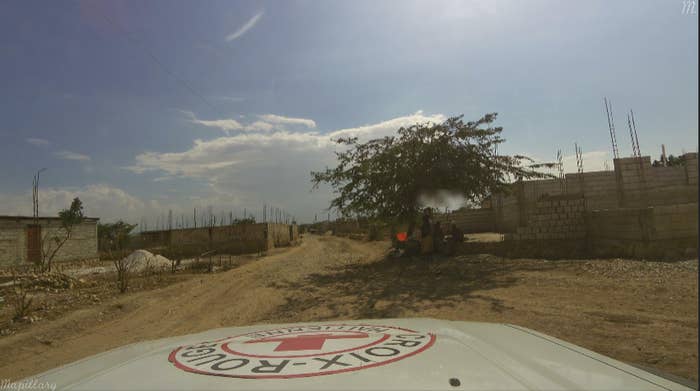
In the developed world, if you don't know where something is, it's usually pretty easy to type it into a search bar and find out within seconds. Whether it's searching the iOS maps app for a nearby bar while standing on a sidewalk or choosing an Airbnb based on Google Street View, at this point, being able to get a sense of the geography of a place instantly is pretty much assumed.
But the companies that make these maps — the Googles, Microsofts and Apples — have an incentive to map places like San Francisco and New York City; that's where their customers are. People who live in places where things like owning a smartphone and having reliable Internet access are not standard are, not at all coincidentally, much less likely to be able to find their homes on a map.
This is a problem for a lot of reasons, not the least of which is, during an emergency or crisis, it's really helpful to be able to find people, to know where roads go, and where certain buildings and facilities are. That's why the Red Cross — along with Doctors Without Borders and OpenStreetMap — teamed up with Mapillary, a crowdsourced visual mapping company, to start filling in the blanks with a project called Missing Maps.
"We joke about [this]: If you have a map and you know where the nearest Starbucks is and you can get there, then the mapping world has already mapped everything that's important around you," Red Cross Geographic Information Systems project lead Dale Kunce told BuzzFeed News. "The places where we work, specifically the Red Cross, there are no Starbucks. The places where we work are blanks on the map."
The Red Cross has been working with OpenStreetMap, an open-source digital cartography tool, to map remote locations such as Haiti, Zimbabwe and Indonesia for almost a year, but Mapillary is a more recent addition to the project. Mapillary is actually a lot like Google Street View, but instead of using special cars with roof-mounted cameras, it relies on volunteers to stick action cameras (like GoPros) on their helmets or cars and upload the images they capture to the web. Mapillary's technology then works to stitch these thousands of images — taken in more than 150 countries — together into a cohesive, useful map.
The advantage, Mapillary CEO Jan Erik Solem told BuzzFeed News, is that while Google is "limited to how much they can cover" by the cost and time required to gather of photos, and thus only hits locations every three or four years, "with a crowdsourced solution, you can go out every day or week or month and take photos of the same street." Mapillary also works with commercial partners to build custom maps, which is how the company can fund open, crowd-sourced, humanitarian projects.
For the Red Cross, Kunce said, the Missing Maps project serves a number of purposes. The first and most obvious is providing access to information the organization needs to execute projects. For example, if you're trying to build housing, you need to know if the road you plan to use is paved. But it's also important to get constant visual updates on how the geography of a location is changing, especially in dealing with crisis situations. A place will look a lot different before and after a natural disaster; Mapillary is a tool that can help the Red Cross negotiate that eventuality.
"A few hundred mile an hour wind is going to blow a lot of things down," said Kunce. "Sometimes, those things are street signs. Knowing what something looked like before the disaster is really important. Instead of saying, go down two miles and turn at First St., we're able to say, go down two miles and turn where you see this building that was knocked over."
But in addition to worrying about famine, civli unrest, and typhoons, the Red Cross needs to worry about something all non-profits do: funding. Mapillary can also provide a sort of before and after of Red Cross efforts which, Kunce said, is very useful when it comes to "donor relations."
"At the end of a multi-year project, we don't just have numbers that say we're increasing the number of people in safe housing by 25%," he said. "But what does that look like when you walk down a street and there's no raw sewage, or there are street lights and it's safe to walk?," he said.
It can be hard to understand at a glance how a crowd-sourced, open-sourced project like Missing Maps could ever hope to compete with the likes of a Google, a company with enormous resources hell-bent on "organizing the world's information." Indeed, Mapillary's Solem said from the beginning the goal was always to be a "complement to that data, rather than a replacement for it."
But, the way Kunce sees it, the Missing Maps project actually has an advantage over companies like Google that allows them to better serve their target population. "The biggest problem with Google, for me as a mapmaker, is that their information is locked away in a site that has really restricted rules about who can use it," said Kunce. "The data itself is not real data, it's just images of data." By being open source and non-commercial, Missing Maps gives the victims of crises a way to access geographical data about themselves in a way that makes it more possible to self-advocate. For Kunce, the satisfying thing about the project is recording and giving agency to populations who otherwise might not be seen.
"Not every humanitarian crisis gets on CNN," he said.
